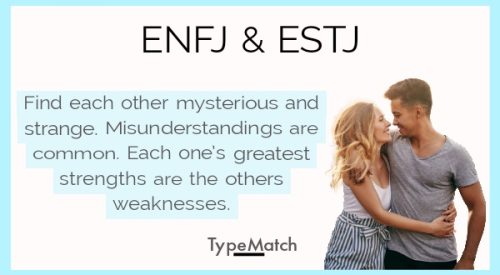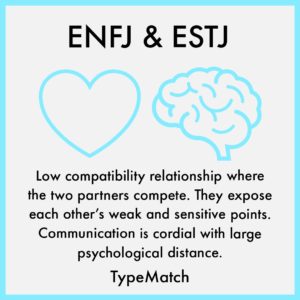ENFJ and ESTJ Relationship
Are ENFJ and ESTJ Relationships Compatible?
In ENFJ and ESTJ relationships, they find each other both mysterious and strange. Because they have trouble understanding the other’s actions and perceptions, misunderstandings are common. TypeMatch assigns this match a very low compatibility score in our free dating and friendship app based on personality type. Below we explain what makes this relationship so intriguing but challenging.
ENFJ & ESTJ Compatibility
ENFJs and ESTJs have a difficult compatibility style that differs from other types of compatibility. They aren’t the best match for a relationship, but it can be fun and fulfilling if they approach each other with care and attention.
The strongest functions of each type corresponding to the weakest functions of the other. This makes both feel exposed and insecure, which leads to disagreements. These two types demonstrate their superiority in ways that the other does not. As a result, the actions of each one either frighten or impress the other. Another common theme in this relationship is that they become very frustrated and hurt when one achieves some of the benefits or success that the other desired. To avoid this, each one should proudly assert that he/she also has knowledge and skills in other areas of life.
As acquaintances, ENFJs and ESTJs can usually maintain a shallow relationship. Both partners often feel attraction and sympathy for each other since they can see their partner’s weak aspects. They can establish a reasonable level of comfort in this pair by exerting some effort to ensure that you don’t hurt each other. It’s critical for ENFJs and ESTJs to respect each other’s differences and recognize that they will face challenges.
They may develop a deeper relationship if forced to interact closely, but it will still be difficult. One partner may appear to assist the other in areas where the latter is insecure. On the other hand, other experts describe them as highly tense and dangerous, with their sudden ‘hits’ at the partners’ weak functions.
Attraction
At first, ENFJs and ESTJs are intrigued by each other’s mannerisms, behavior, and speech. This couple finds each other mysterious and strange at times, which is why they interact coldly. They are, of course, impressed and admire each other’s ability to think outside the box.
Communication
Communication between two people can be difficult, and communication between the ESTJ and ENFJ personality types is no exception. They can learn to understand more quickly if they know the issues that frequently arise when ESTJs and ENFJs communicate.
Between these types, it is normal to have trouble understanding each other- they think they understand each other, but they don’t, deepening their divide. They must be careful in communicating formally unless they both have an interesting topic that leads to interesting conversations. Either way, communication is interesting but sometimes is too monotonous and tiresome. It takes a lot of effort to introduce an element of novelty and originality.
In daily life, ESTJs and ENFJs have different interests and understanding is difficult. As a consequence, they have frequent arguments. When they speak to each other, each type wants to express their point of view more than listen to the other- both making their points and not having a real conversation. So, these types impose their views and don’t give space to the other person.
They must keep interactions short and centered around common interests if possible. Overall, their prolonged interaction for these types is draining and frustrating.

ESTJ and ENFJ Relationships
Relationships are approached differently by ENFJs and ESTJs, and it is critical to recognize this from the start. They are cordial and polite if they don’t know each other well. However, relationships of close proximity can be difficult to navigate.
To put it another way, we have two extraverts, one of whom believes the other does not pay enough attention to them. ENFJs and ESTJs tend to develop a rivalry when they are in the same environment. They both try to brag and make the other appear less valuable. When they have a long-lasting interaction and friction and deal with a lot of tension, their behavior changes quickly. Different emotional reactions result from mutual frustration. These personalities do not understand each other and will inevitably struggle to trust and empathize with one another. Both are left feeling lonely and misunderstood, and they may be able to hurt each other.
Naturally, the future development of their relationship is primarily determined by the partners’ level of development and protection of the partner’s Superego block. Each of them gradually demands more attention than the other person is willing to give him/her. As a result, partners begin to judge one another as selfish.
Minor disagreements and disputes are unavoidable components of close relationships between ENFJs and ESTJs. Unfortunately, in reality, these conditions are rarely ideal. As a result, superego influence is usually unpleasant. To avoid upsetting these relationships, partners should never persist in attempting to reach, change, or remake one another in a short period of time.
ENFJ and ESTJ relationships can be very passionate, but they are also characterized by irrational behavior toward one another. In these relationships, there is a constant sense that your partner is doing everything wrong on purpose, disregarding your wishes and needs, and trying to frustrate you deliberately. There will also be attempts to revenge. Long story short, partners begin to perceive each other as egotistical.
Partnership
ENFJs and ESTJs don’t collaborate well and don’t intend to help each other achieve their goals. Simply put, they don’t get along. When a project has to be done, these two will create chaos working together. It is impossible to take on common tasks because of their differences in approaches and methods. To each one, it seems like the other is trying to ruin everything and doing things to spite them. It feels like they intentionally want to upset each other. These types won’t bother explaining or understanding each other’s intentions and they feel like they can’t rely on each other.
Still, there is hope for ENFJs and ESTJs to learn from each other in small ways. Even if relations are shallow, they can still be very informative because the Superego block, like a sponge, absorbs all the interesting experiences of the mature Ego block of the partner.

Advice For This Couple
Overall, ENFJs and ESTJs must maintain a large psychological distance because they can annoy one another at closer distances. Each one must treat their partner’s weak points the way they would like them to treat their own.
As a couple, they are dynamic and need frequent changes in activities and surroundings. They should broaden their circle of acquaintances, particularly from other cities and distant regions. ENFJs and ESTJs should do something mutually beneficial by focusing on their partner’s positive qualities and complimenting them. It would help if they tried to be adaptable and diplomatic. Furthermore, they should always be fair and not gain things at their partner’s expense.
Personal factors such as both partners’ spheres of activity, common interests, social status, and so on play a decisive role in developing these relationships. When minor disagreements arise, resolve them with minor compromises. The best thing to do is that partners should pause and take periodic breaks from each other. Everybody needs space and understanding time after time.
More Resources for ENFJ & ESTJ Relationships
TypeMatch is your #1 resource for personality and love. We’re here to help guide you to getting a relationship where you feel understood. Check out more of our free resources below for ENFJs and ESTJs in love.
Are you an ENFJ or ESTJ looking for your match? Try the Free TypeMatch Dating App!
Check out the relationship pages for both personality types: ENFJ, ESTJ
Find out about the type’s compatibility with other personality types: free compatibility chart
Sources:
A.V. Bukalov, G. Boiko, “Why Saddam Hussein made a mistake, or what is Socionics”
Ekaterina Filatova “Art of understanding yourself and others”
Eugene Gorenko, Vladimir Tolstikov, “Nature of self”
I.D. Vaisband, publications on Socionics
Laima Stankevichyute “Intertype relations”
O.B. Slinko, “The key to heart – Socionics”
R.K. Sedih, “Informational psychoanalysis”
Sergei Ganin
Valentina Meged, Anatoly Ovcharov
V.V. Gulenko “Criteria of reciprocity”
V.V. Gulenko, A.V. Molodtsev, “Introduction to socionics”



